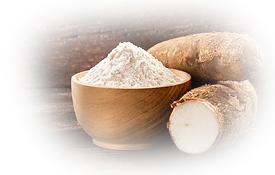What is Cassava Starch & Telobag Suggested Usage

About Cassava
Widely grown in Indonesia, it is a root crop often hailed as the war-time crop as it is remarkably easy to grow and often pulls farmers out of poverty.
Why? It is one of the few staple crops that can be produced efficiently on a small scale, without the need for farming machines or fertilisers, herbicide, pesticides, and in marginal areas with poor soils and unpredictable rainfall.
Mainly grown by low-income, smallholder farmers as sustenance, cassava can grow rapidly (~6 months) without much water, fertilisers or maintenance. As of date, it feeds 800 million families from their own backyards.
As a crop, cassava already has advantages in production, such as high yields per hectare, tolerance to drought and degraded soils, and great flexibility in planting and harvesting.
About Cassava Starch
As a source of starch, it is highly competitive: the root contains more starch, by dry weight, than almost any other food crop, and the starch is easy to extract using simple technologies.
The starch has long been used as stabilizers in soups and frozen food, as coating on pills and paper, as adhesives on stamps and plywood, as a stiffening agent in textiles, as raw material for making ethanol, and even as binder in concrete.
“Cassava makes a really excellent starch,” says Danilo Mejía, an agricultural engineer with FAO’s Agricultural Support Systems Division, who is coordinating the preparation of a new manual on cassava starch extraction for developing countries. “Compared to starches derived from most other plants, it has greater clarity and viscosity, and it’s very stable in acidic food products. It also has excellent properties for use in non-food products, such as pharmaceuticals and thermobioplastics.”
As cassava is a low-value crop, demand for cassava starch has increased the selling price for cassava, which in turn increase the income for smallholder farmers. This is done by converting more of that relatively low-cost raw material into high-value starch.

Source: Food and Agriculture Organization of the United Nations
Suggested Usage
Suitable for:
-Fruits & Vegetables
-Laundry (Infection Control)
-Kitchen and Paper Waste (Properly Drained)
-Various Packaging Purposes
Optimal Storage Method:
-Avoid Direct Contact with Hot Water
-Keep Away from Direct Sunlight
-Room Temperature of 22-30 Degrees Celcius
-Store any Unused Bag in Closed Container